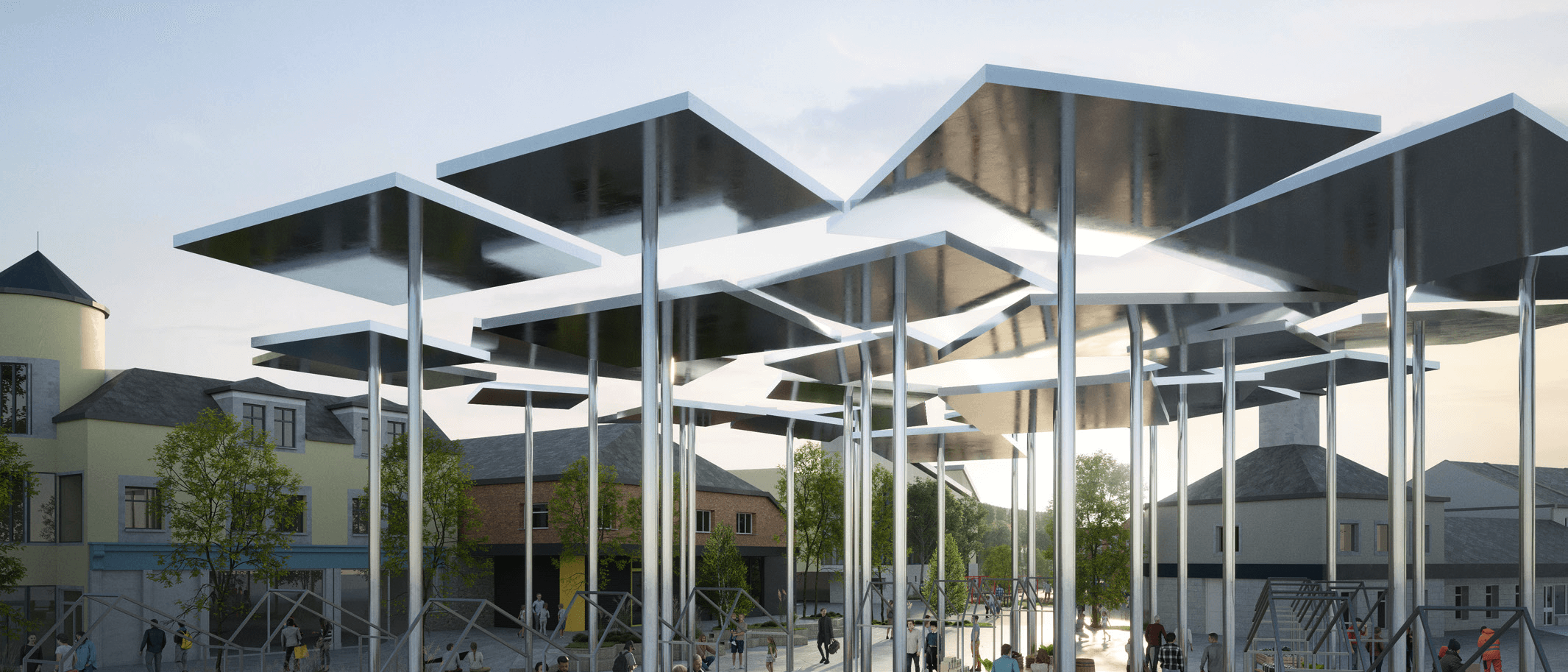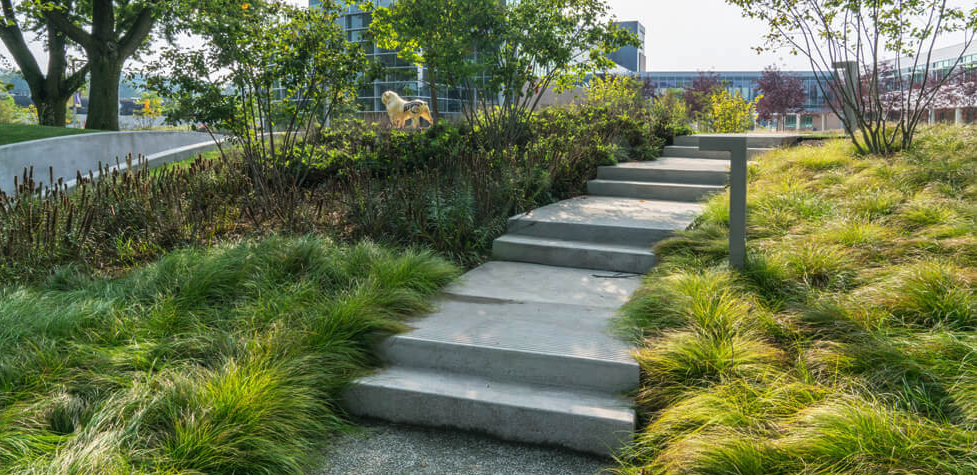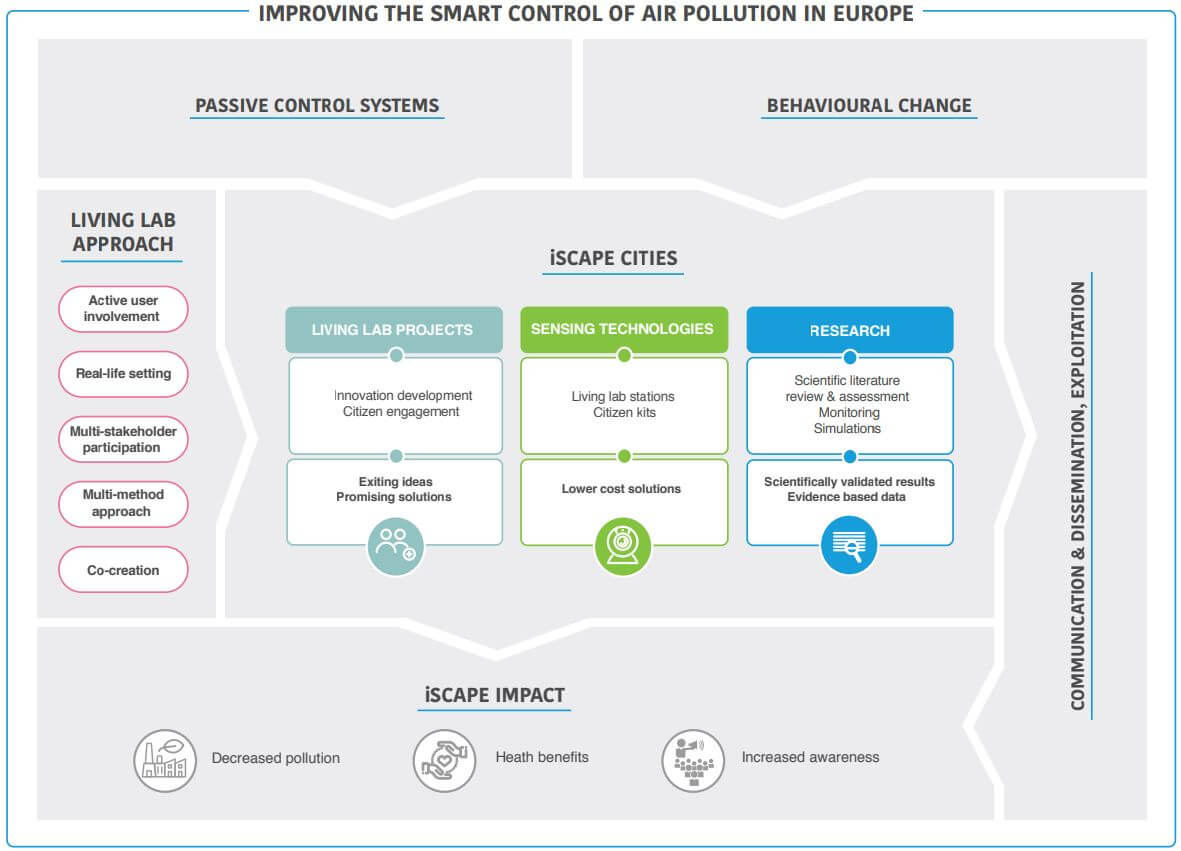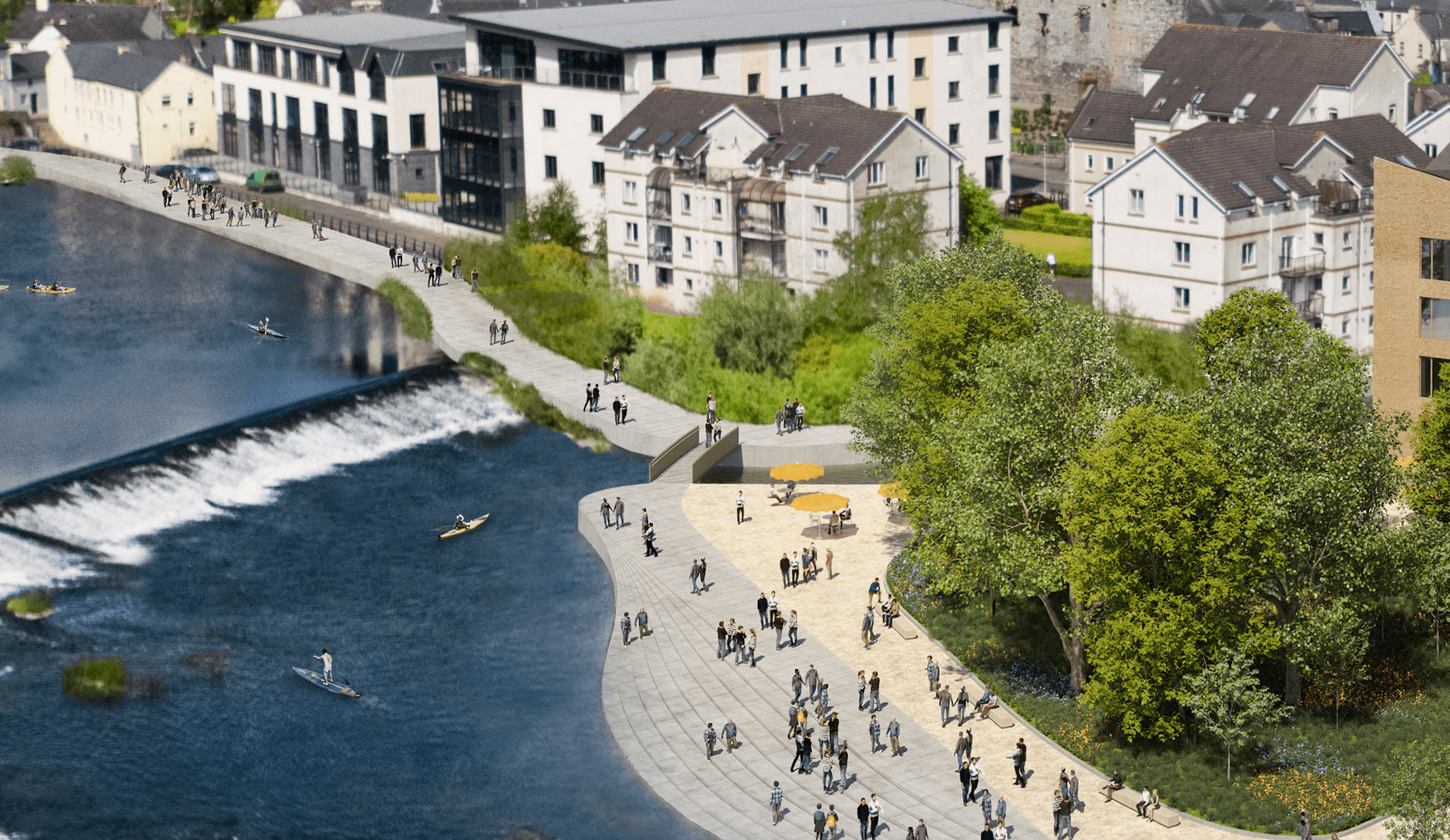4. Environment and Sustainability
Policy Overview
“Formulate, implement, publish and regularly update national and, where appropriate, regional programmes containing measures to … facilitate adequate adaptation to climate change.” United Nations Framework Convention on Climate Change
As set out within the National Adaptation Framework, a substantial body of international and EU climate change policy now exists to guide the development of national policy. These policies frame the objective of transitioning to climate resilience and realising inherent opportunities. A summary of key policy documents, while not exhaustive, is set out as follows.
COP21/Paris Agreement: The Conference of Parties (COP21) agreement signed by 179 member states places a commitment on governments to reduce greenhouse gas emissions by 40% before 2030. The Irish Government have committed to reducing emissions by 2020 and 2030 relative to 2005 levels. Ireland has received some flexibility regarding their reductions through emissions trading and land use.
Local Authorities EU agreements: As signatories of the European Union’s Covenant of Mayors for Climate and Energy Initiative, local authorities are required to monitor at County level, energy consumption, CO2 emissions and to report on the progress of relevant action plans. The implementation of such action plans and mitigatory strategies is critical in urban areas, which contribute the largest proportion of overall emissions (70% globally) and similarly comprise of the majority of services, employment and persons.
National Climate Policy: This policy establishes the fundamental national objective of achieving transition to a competitive, low carbon, climate-resilient and environmentally sustainable economy by 2050. It sets out the context for the objective, clarifies the level of greenhouse gas mitigation ambition envisaged, and establishes the process to pursue and achieve the overall objective. The evolution of climate policy in Irelandwill be an iterative process based on the adoption by government of a series of national plans over the period to 2050.
Climate Action and Low Carbon Development Act 2015: The Act is Ireland’s first overarching piece of climate change legislation. It has two main aims: to design a national mitigation plan to reduce or prevent greenhouse emissions; and the development of a National Adaptation Framework to reduce the negative effects of climate change.
Climate Action Plan 2019: This Plan sets out an ambitious course of action over the coming years to address climate disruption. The Plan outlines the current state of play across key sectors including Electricity, Transport, Built Environment, Industry and Agriculture and charts a course towards ambitious decarbonisation targets. The Plan sets out governance arrangements including carbon-proofing policies, establishment of carbon budgets, a strengthened Climate Change Advisory Council and greater accountability to the Oireachtas.
National Mitigation Plan: The NMP was published in 2017 and sets out the government’s shared approach to reducing greenhouse gas emissions. It is a whole-of- government Plan, reflecting in particular the central roles of the key Ministers responsible for the sectors covered by the Plan namely – electricity generation; the built environment; transport, and agriculture, as well as drawing on the perspectives and responsibilities of a range of other government departments. The Plan sets out measures that lay the foundations for transitioning Ireland to a low carbon, climate resilient and environmentally sustainable economy by 2050.
National Adaptation Framework (Planning for a Climate Resilient Ireland): Ireland’s first statutory National Adaptation Framework (NAF) was published in January 2018 by the Department of Communications, Climate Action and Environment. The NAF sets out the national strategy to reduce the vulnerability of the Country to the negative effects of climate change and to avail of positive impacts. The NAF was developed under the Climate Action and Low Carbon Development Act 2015. The NAF builds on the work already carried out under the National Climate Change Adaptation Framework 2012.
National Planning Framework: The NPF represents a key opportunity in ensuring that the climate implications of our spatial choices are fully considered and addressed from the top of the planning hierarchy. The planning process provides an established means through which climate change adaptation objectives can be integrated and implemented at local level. Within the NPF, NPO 54 sets out the requirement to ‘Reduce our carbon footprint by integrating climate action into the planning system in support of national targets for climate policy mitigation and adaptation objectives, as well as targets for greenhouse gas emissions reductions’.
Carlow County Development Plan 2015-2021: The Carlow County Development Plan identifies various policies and objectives in relation to a number of factors within the County such as Waste Management, Soil, Air and Noise Quality, Flooding, Climate Change and Water Services. The Development Plan outlines, with respect to Air Quality, that ‘The role of the Local Authority is to protect, enhance and control air pollution and to ensure the provision of the highest standards and is empowered to improve air quality and prevent pollution by having regard to the Air Quality Standards Regulations 2011 (S.I. No. 180 of 2011)’. It is recognised that air pollution can have negative effects on human health and ecological systems and Carlow County Council notes that the main cause of this is vehicular traffic.
Carlow County Climate Change Adaptation Strategy 2019-2024: This Strategy has been prepared in response to the global shift to climate change adaptation and has been informed by national, regional and local research to manage growth and development. The Strategy outlines a number of Climate Hazard Events which have occurred throughout the County and the Town of Carlow such as ‘Extreme Heat Event (2018)’, ‘Extreme Flood Event (2009)’, ‘Extreme Cold Spell (2009/10)’. These events have had an impact on the community, health and wellbeing, natural resources, infrastructure and the built environment.
National Context
Ireland has a number of key climate challenges, such as sea level rise, pluvial and fluvial flooding, extreme
weather events and extreme temperatures. Under various EU directives that have been transposed as statutory instruments, Ireland has been set national targets and these directives require that certain targets for energy efficiency, renewable energy and greenhouse gas reductions are achieved by 2020, namely:
- 20% reduction in non-emissions trading scheme (ETS) greenhouse gas emissions relative to 2005 levels;
- Raising the share of EU energy consumption produced by renewable resources to 20% (adjusted to 16% for Ireland);
- 20% improvement in the EU’s energy efficiency; and
- In line with the National Energy Efficiency Action Plan (NEEAP), the DLAs are committed to achieving a 33% improvement in energy efficiency for their own operations.
According to the Environmental Protection Agency, in 2018 Ireland’s provisional greenhouse gas emissions were estimated to be 60.51 million tonnes (carbon dioxide equivalent) which is 0.2% lower than emissions in 2017, following a 1.0% decrease in emissions reported for 2017. Emissions reductions have been recorded in 7 of the last 10 years. However, in the agriculture, transport, residential, manufacturing/ industrial, commercial and public sectors, emission trends have increased making the achievement of Ireland’s long-term decarbonisation goals ever more difficult. Arresting this growth is a challenge in the context of a growing economy but one which must be addressed by households, business, farmers and communities if Ireland is to reap the benefits of a low- carbon economy.
Sustainable Development Goals
The United Nations’ 2030 Agenda for Sustainable Development includes 17 Sustainable Development Goals (SDGs) which each have a number of targets associated with it – 169 targets in total. Inclusion is at the core of the UN SDGs, and as a result, governments, the corporate sector, and citizens are called upon to make the SDG agenda a reality.
Carlow County Council has been selected as a Champion for the implementation of the UN Sustainable Development Goals in Ireland 2019/2020. Carlow is the only Local Authority to be selected as a champion along with 11 other organisations including An Post, Musgraves and the GAA. The purpose of the SDG Champions Programme is primarily to raise public awareness of the SDGs, and secondarily to illustrate practical ways in which organisations and individuals can contribute to achieving the SDGs, using Champion organisations’ practices as examples.
The focus of Carlow as part of the SDG Champions Programme includes SDG No. 11 – Make Cities Inclusive, Safe, Resilient and Sustainable. Carlow County Council seeks the achievement of SDG No. 11 by promoting social inclusion for all citizens and recently settled residents through their social inclusion and community activation programme and encouraging sustainable development of rural communities through rural recreation and village development programme.
Carlow County Council is committed to working for the common good of citizens, in partnership with communities and relevant agencies, to deliver quality services and to promote sustainable economic, social, and cultural development for current and future generations.
The introduction of the principles of sustainable growth within the regeneration of Carlow Town Centre as part of this Strategy will provide an exemplar for future development in the region and country.
Regional Context
The RSES for the Southern Region provides direction for Local Authorities in guiding future development in an environmentally sustainable manner by following a number of principles and objectives. In order to combat climate change, the RSES outlines a number of areas that can be addressed as part of climate action. The particular areas of action which can addressed through the regeneration of Carlow Town are as follows;
|
Transition to a low carbon economy and society |
“The transition to a low carbon energy future will require a wide range of responses across the public and private sectors and in communities to change how we use energy at home, in our work and how we travel.” |
|---|---|
|
Climate Resilience |
“Climate adaptation aims to reduce the vulnerability of our environment, society and economy to the current and future risks posed by climate change.
It focuses on short-term and long-term responses to climate change by taking a cross- cutting themed approach for all key sectors of Government, society and the economy.” |
|
Resource Efficiency |
“A determined focus on resource efficiency means using the Earth's limited resources in a sustainable manner while minimising impacts on the environment.” |
|
Energy Efficiency |
“Economy: Measures which reduce reliance on the use of imported fossil fuels and enhance economic competitiveness and support the reduction of emissions.
Households: Measures to improve the energy efficiency of households and address energy poverty through domestic supports under the Better Energy Programme, including the Deep Retrofit Pilot Scheme.” |

Rainwater Harvesting Canopy in Potato Market
Climate Context
Evidence and research to date demonstrates a clear appreciation that greenhouse gas emissions, including carbon dioxide and methane, are responsible for climate change. The Intergovernmental Panel on Climate Change (IPCC) advise that greenhouse gas emissions have increased by 70% between 1970 and 2004 due to human activity, meaning that human activity is the driving factor for climate change.
The changing climate will have significant implications for Ireland’s governmental institutions’ economy, society and environment. Adapting to these challenges is critical and will require a concerted effort at all levels of government and society to move to a holistic and robust strategy to reduce greenhouse gas emissions and adapt the built environment to a more inclement climate.
As set out within the National Adaptation Framework, adaptation not only depends on action by all levels of government but also on the active and sustained engagement of all stakeholders, including sectoral interests, the private sector, communities and individuals. Most adaptation measures to date in Ireland have been reactive in nature and given the increased knowledge of climate change impacts, it is now necessary to adopt a planned approach to adaptation so that we are better placed to deal with the short and long term impacts of climate change.
Climate Adaptation
Climate adaptation is the principle of dealing with the negative effects as a result of climate change. The Government of Ireland’s National Adaptation Framework is a national commitment to exposing the positive aspects of adapting to climate change within our urban and rural environments. Carlow Town has a duty to review climate change policies in respect of future development and identify certain procedures that will provide a positive change to the environment while also maintaining growth and acceptance amongst the public arena.
According to ‘Climate ADAPT’, a leading organisation in climate adaptation protocol, there are a number of key principles that can be adopted in the Carlow Town Context which will contribute to the national goals for climate change adaptation as follows;
- Adaptation needs to be sustainable;
- Work needs to be done in partnership;
- Adaptation needs to be evidence-based;
- Risks should be managed through a balanced approach;
- Response to climate impacts should be prioritised;
- Adaptation should be flexible; and
- Adaptation needs to be transparent.

Reference Image for Carlow College Link to Train Station
Carlow Town Context
Carlow Town is a compact urban development with a population of 24,272 as of the 2016 Census which includes the area of Graiguecullen in County Laois across the River Barrow to the west. Carlow Town contains many natural assets which contribute enormously to its attraction as a tourist destination and help with promoting the various events and festivals that take place in the Town and County.
Carlow Town has the opportunity to adapt to climate change measures through its physical urban regeneration and the principles which have been presented as part of this Strategy.
This can be achieved through the following;
-
Development Change
- Spatial: Focusing development on the core of Carlow Town.
- Movement and Air Quality: Becoming aware of our impact on the climate and making a positive change for the future.
- Health and Wellbeing: Placing an emphasis on healthy living through urban design practices.
-
Environmental Assets
- Green and Blue Infrastructure: Increase use of the River Barrow and Burren River as green and blue areas for leisure and amenity and also as sustainable industries.
This Regeneraton Stratgey seeks to undertake a number of green and blue infrastructural interventions in Carlow Town. Through the incorporation of nature based solutions such as rainwater harvesting, green walls and the use of solar energy in the Town Centre, as well as the greening of parking spaces on Barrack Street, Carlow Town will be an exemplar in environmental and sustainable measures. Carlow Town will provide the opportunity for amenity and recreation spaces along the riverfront while providing sustainable public realm spaces & routes within the Town Centre. These measures will support Carlow’s position as an UN Sustainable Development Goal Champion.
Improving Air Quality
In order to improve air quality within our own environment, we need to understand the current levels and how it affects our daily lives. Awareness of our daily impact on air pollution can provide the necessary conditions for changing behaviour and providing an overall societal shift towards sound environmental management with overall community health benefits.
The Ca se Study following demonstrates a European wide initiative to overcome a societal change and transformation in our behaviour towards air quality and daily contribution towards air pollution. The use of physical monitors in the urban environment can be linked with a mobile application allowing members of the community to be aware of the level of pollution in a particular area due to a wide variety of factors, most commonly vehicular traffic. Individuals can choose to avoid such areas and/or choose to take alternative forms of transport, e.g. walking and cycling, in order to reduce their overall impact.
se Study following demonstrates a European wide initiative to overcome a societal change and transformation in our behaviour towards air quality and daily contribution towards air pollution. The use of physical monitors in the urban environment can be linked with a mobile application allowing members of the community to be aware of the level of pollution in a particular area due to a wide variety of factors, most commonly vehicular traffic. Individuals can choose to avoid such areas and/or choose to take alternative forms of transport, e.g. walking and cycling, in order to reduce their overall impact.
Other ways in which air quality can be improved in society is through good quality urban design which provides the conditions that promote walking and cycling, particularly in urban settings.
The Interventions identified in this Strategy have incorporated features within the public realm that aim to reduce overall car numbers required and allow for more urban green space to walk, cycle and exercise.
CASE STUDY: iSCAPE (IMPROVING THE SMART CONTROL OF AIR POLLUTION IN EUROPE)
iSCAPE was a European research and innovation project active from September 2016 to December 2019. The project worked on integrating and advancing the control of air quality and carbon emissions in European cities in the context of climate change through the development of sustainable and passive air pollution remediation strategies, policy interventions and behavioural change initiatives.
It tackled the problem of reducing air pollution impacts, focusing on the use of “Passive Control Systems” in urban spaces, on policy intervention and behavioural changes of citizens lifestyle. Projections and real-world physical interventions were applied on the urban tissue in the selected cities assessed for future climate change scenarios and representative of different cultural & lifestyles in Europe.
Through the approach of Living Labs the team deployed a network of air quality and meteorological sensors (both stationary and mobile) and evaluated the benefits expected from the interventions on a neighbourhood and city-wide scale, ranging from quantification of pollutant concentration to exposure.
iSCAPE encapsulated the concept of “smart cities” by promoting the use of low-cost sensors and engaging citizens in the use of alternative solution processes to environmental problems. The project supported sustainable urban development by sharing the results with policy-makers and planners using local test-cases, and providing scientific evidence ready-to-use solutions potentially leading to real-time operational interventions.

Expected Results from the iSCAPE project:
|
The proposed interventions can produce a reduction of the negative effects on health and climate together with the costs associated with air pollution in the EU. |
|
Lower concentrations of air pollutants in cities can be achieved using technologies adapted to local needs, such as: low boundary walls, green walls and roofs, photocatalytic coatings, changes in activity patterns to reduce congestions, etc. |
|
iSCAPE can assess ex-ante a range of behavioural change interventions such as (1) actions to promote changes in transport mode choice for EU Cities inhabitants; (2) action to promote changes in activity patterns. |
|
iSCAPE can test and deploy solutions that can be produced at a relative low cost and that can be exploiting using different complementary business models. |
|
iSCAPE can assess the effectives and thus design guidelines of smart interventions in practice to integrate them into urban design and planning policy following a “win-win” approach for climate change and air pollution abatement. |
|
iSCAPE can foster a societal transformation to a green and low carbon economy by engaging citizens in citizens-science activities as part of the Living Labs. |

River Barrow
Achieving Sustainable Development
Achieving Sustainable Development Collaboration
Key to the success of the Carlow Town Regeneration Vision and Implementation Strategy is the creation of a level of ‘buy-in’ by the community and end users who are living, working and studying in Carlow Town.
The idea of ‘local capital’ is established through the development of a robust framework which involves members of the public working collectively with community organisations, private landowners, businesses and the local authority.
The positive results which can be achieved by this level of engagement are evident in other international examples (See Freiburg, Germany).
Sustainable Growth
The NPF outlines various policies towards sustainable and compact urban growth within Ireland and these practices have been integrated into the designs for the interventions.
Urban infill development is central to the delivery of a ‘liveable’ city or town which focuses needs on the community in order to improve the perceived ‘quality of life’ of its residents and ultimately attract investment and achieve growth.
Investment
Ireland relies on inward investment from multi-national companies and investment to date in Carlow Town continues to be dominated by foreign companies which contribute to the current growth in economic and social trends in the County.
Creating the environment for growth within the existing urban space of the Town is a challenge which can be addressed through the interventions outlined in this Strategy. For example, the former Cash & Carry Site located on Kennedy Street can be developed to accommodate an office type development which would encourage the growth of new and existing businesses in the Town and
provide the necessary resources to support them. Working in conjunction with the existing educational institutes in the Town can serve to develop emerging technologies in the growth of niche industries and provide a unique opportunity for Carlow Town to become a specialist region for new technologies.
Community Networking
Carlow Town has a strong community network consisting of local residents, traders, business owners and local councillors. The Carlow Town Development Forum can assist Carlow County Council in the implementation of the Carlow Town Regeneration Strategy through collaboration with the Local Authority, private landowners and any other organisations with a an involvement in the development of the Town as a whole.
It is important that strong links are created in order facilitate the growth of the Town through the interventions identified in this Strategy and to implement the shared vision which has evolved through public consultation processes.
Principles of Sustainable Development
The principle of sustainable development is entrenched in Goal 11 of the United Nations Sustainable Development Goals which aims to ‘Make cities and human settlements inclusive, safe, resilient and sustainable’. The targets outlined as part of this Goal are aimed at developing policies and procedures to reduce reliance on fossil fuels, pay attention to air quality and waste management, provide universal access to green and public spaces, and to support positive economic, social and environmental links between urban, peri-urban and rural areas by strengthening national and regional development planning.
Carlow Town in 2040
The vision for Carlow Town in 2040 combines a variety of factors to work together in unison, such as the built environment, the community, local governance and, importantly, a focus on environmental sustainability.
It is through awareness of our daily impact on the climate that we as a society can become much more environmentally conscious and move towards a more sustainable way of living. This would require a noticeable reduction in car usage, the promotion of walking and cycling, increased use of public transport, changing how we shop and adaptation towards alternative forms of construction and manufacturing.
Carlow Town has the opportunity to become a national leader in sustainable methods of living and the progression of the UN Sustainable Development Goals.
Sustainability Principles
Safeguarding and enhancing our environment is not only an environmental sustainability issue but is also an economic, social and public health and wellbeing consideration. National level guidance seeks to deliver such protection through sustainable development and the transitioning to a competitive, low carbon and climate resilient economy by 2050.
As mentioned previously, in 2019 Carlow County Council was selected as a Champion for the implementation of the UN Sustainable Development Goals (SDG’s) in Ireland. The future economic and social development of Carlow should be considered in the context of the protection and enhancement of its natural environment. This Regeneration Strategy presents Carlow with the opportunity to truly champion the SDG’s, especially
Goal 11: ‘Make cities and human settlements inclusive, safe, resilient and sustainable’, supporting Carlow in becoming an exemplar in sustainable regeneration projects.
Sustainability is defined as meeting the needs of the present, without compromising the ability of future generations to meet their needs. There are three main pillars: economic, environmental and social, and each proposed intervention Area in this Regeneration Strategy has been considered in context to all three.
Therefore, alongside the Health & Wellbeing Principles which are outlined for each Intervention Area, there are a number of Sustainability Principles which each Intervention Area will align with and they include the following inter alia:
- Prioritising walking, cycling and public transport use;
- Facilitating appropriate and well designed access to natural spaces, features and landscapes;
- Maintaining, enhancing and protecting healthy air and water and enhancing biodiversity resources;
- Provision of new and improved urban green infrastructure;
- Improving connectivity between the Town Centre and natural assets such as the River Barrow and River Burrin;
- Improving public transport connectivity for Carlow both locally and regionally;
- Creating a vibrant Town Centre through the delivery of an enhanced public realm with improved accessibility for sustainable transport modes;
- Promoting the delivery of energy efficient buildings, sustainable energy measures for the public realm and encouraging innovative solutions from the private sector; and
- Supporting compact urban growth by building on existing assets and capacity to create critical mass and scale for regional growth.
Outcomes and Actions
A set of Outcomes have been derived and formulated in relation to the Environment Core Theme. An associated Action accompanies each that provides a clear direction for the delivery of the Outcome.
|
1 |
Support Carlow in its path to reduce resource consumption and transition to a low carbon society with appropriate climate change mitigation and adaptation measures. |
|---|---|
|
|
|
|
|
* Transition to a low carbon society. |
|
* Improved health and wellbeing. |
|
|
* Promotion of carbon reduction measures e.g. increased levels of walking and cycling. |
|
|
* Encouraging biodiversity within the public realm. |
|
|
* Reduction in air and noise pollution. |
|
2 |
Introduce sustainable growth principles in the regeneration of Carlow Town Centre in line with this Strategy to support Carlow County Council in its position as an UN Sustainable Development Goal Champion. |
|---|---|
|
|
|
|
|
* Carlow Town will be an exemplar for future development in the Region and Country. |
|
* Focus on creating quality public space and public realm. |
|
|
* Integrating unique amenity and biodiversity spaces into the urban fabric. |
|
|
* Build resilience, flexibility and adaptability, specifically climate adaptation, into Carlow. |
|
|
* Community focused forms of development. |
|
3 |
Protect and enhance Carlow Town’s unique biodiversity and landscape and support these natural assets through the delivery of the Intervention Areas. |
|---|---|
|
|
|
|
|
* A better quality of life for residents. |
| * Increased use of the River Barrow and Burren River as green and blue areas for leisure and amenity and also as sustainable industries. | |
| * Promotion of walking and cycling as primary modes of transport within the Town. | |
| * Improved air quality through reduction in car usage. | |
| * Attract tourists/visitors to Carlow Town. |
|
4 |
Support innovative building solutions in development within the 6 Intervention Areas. |
|---|---|
|
|
|
|
|
* Opportunity to create a new image and identity for the Town Centre. |
| * Incorporation of nature based solutions such as rainwater harvesting and the use of solar energy. | |
| * Creation of opportunities for sources of funding. |
